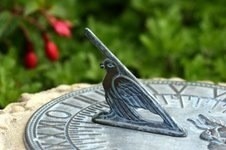
Thousands of years ago sundials were the primary means used to keep track of time. Early sundials tracked the length of daylight through changing seasons, dividing the hours from sunrise until sunset into equal parts. Although they still exist, today's sundials are often thought of as little more than decorative relics for the garden. If you set them up properly, however, they can still be used to tell "solar" time. Here's a simple way to set up horizontal (flat) sundials.
Sundials indicate time by casting the sun's shadow onto a surface (known as a dial) that is inscribed with numbers or symbols representing hours in the day. With some models, it's also possible to determine the month or day of the year, and get information on the horizon and the equator.
Setting sundials to keep accurate "clock" time involves making three adjustments: one for the location within your time zone, a second for summer (length of days), and a third for the non-uniformity of solar time (the Earth's orbit speed and the tilt of its axis varies, so without adjustments, time will vary as much as 16 minutes faster or slower at different times of the year). The dial face and the plinth also need to be set at angles relative to your latitude.
When placing your garden sundial, choose an open spot in full sun. Lay it on a level surface (use a flat stone, tree stump, or a plinth designed specifically for sundials) where it's convenient to view. Make sure it lays level, but don't attach it permanently. You'll need to be able to turn the dial periodically to adjust it to the correct time.
Noon is the hour in your local time zone is when the clock time shows 12 pm. Solar noon, also called "sun transit", is the moment when the sun appears highest in the sky, which depends on your latitude, longitude, and the current date. It's nature's time, not the neatly divided 24-hour "human" time as shown by our clocks. To find out when (in clock time) "solar" noon happens where you live, visit the U.S Naval Oceanography Portal's website, plug in your city and state (or province), and look for your "sun transit" (listed between sunrise and sunset).
This is the clock time adjusted for your location, when the sun is highest overhead where you live (solar noon).
Here are three easy ways to find true north (not compass north).
http://www.ngdc.noaa.gov/geomagmodels/Declination.jsp
Plug in your zip code to compute your declination value. If the value given is east of the line (negative), turn the ring on your compass clockwise; if the value given is west of the line (positive), turn the ring counterclockwise.
At solar noon, face true north and turn the sundial so that the shadow of the gnomon falls on the noon mark on the dial. You're now on sun time! For optimum accuracy, set (or reset if necessary) your dial on one of the four days of the year that that sun time and clock time actually agree: April 15, June 14, September 2 and December 25. If you prefer, at solar noon you can also set your sundial to the current clock time.

About The Author: Ellen Brown is an environmental writer and photographer and the owner of Sustainable Media, an environmental media company that specializes in helping businesses and organizations promote eco-friendly products and services.
Add your voice! Click below to comment. ThriftyFun is powered by your wisdom!
Thank you, interesting. However, not 'everything is reversed in the Southern hemisphere'. The sun rises in the east, and sets in the west too! Frank, Pretoria, south Africa
Thanks for the correction. I think the author was confused by celestial rotation. I have removed that part of the article.
If you set up a sundial, please tell us how it works out and if there are any differences for setting it up in the Southern Hemisphere.
Add your voice! Click below to comment. ThriftyFun is powered by your wisdom!